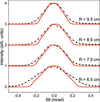issue contents
PhotonDiag2018 Workshop special issue
Edited by E. Ploenjes, D. Cocco, J. Grünert, K. Tiedtke and M. Zangrando
The articles in this virtual special issue of Journal of Synchrotron Radiation represent some highlights of the PhotonDiag2018 Workshop. The issue brings together articles originally published in the journal between May 2019 and January 2020.

Cover illustration: Group photograph from the PhotonDiag2018 workshop.
facility information
Free 

Foreword to the virtual issue papers from the PhotonDiag2018 workshop.
Grating structures with 150 nm pitches were fabricated on free-standing CVD diamond membranes supported by a silicon frame. The efficiencies and structural homogeneity of the gratings were measured with synchrotron X-rays at different photon energies.
Diffraction properties of strongly bent defect-free diamond crystals have been measured and compared with the modelling based on the Takagi–Taupin equations.
Commissioning of a photoelectron spectrometer for soft X-ray photon diagnostics at the European XFEL
Commissioning and first operation of an angle-resolved photoelectron spectrometer for non-invasive shot-to-shot diagnostics for photon energy and polarization at the European XFEL soft X-ray beamline SASE3 are described.
Open  access
access
 access
accessHere a direct comparison is made between various X-ray wavefront sensing methods with application to optics alignment and focus characterization at X-ray free-electron lasers. Difference wavefront measurements with and without a corrective phase plate agreed with its design to within λ/20, enabling a direct quantitative comparison between methods.
Open  access
access
 access
accessCharacterization of the absolute photon pulse energy and beam position of free-electron lasers (FELs) is essential for many user experiments, as well as for machine operators. Described here is an X-ray gas monitor which is a suitable tool for FEL photon diagnostics over a broad spectral range from vacuum ultraviolet to hard X-rays.
Installation, commissioning and operation of X-ray gas monitors at the European XFEL are described. These monitors measure non-invasively single-shot pulse energies and average beam positions.
Photon diagnostic imagers provide information on the X-ray free-electron laser beam along the photon-transport path from the undulators up to the scientific instruments.
Open  access
access
 access
accessPolarization control using an X-ray phase retarder in combination with an arrival timing diagnostic on BL3 of SACLA is reported.
Open  access
access
 access
accessA THz plasma switch, driven by ultrafast XUV pulses for temporal ovelap in pump–probe experiments, is presented.
Focusing of a Gaussian beam through an elliptical mirror is addressed. Focus shifts induced by displacements of the source longitudinal position and pointing, then amplified by mirror surface defects, are investigated.
Open  access
access
 access
accessThe European XFEL requires long and ultraflat X-ray mirrors of high precision for the beam offset and distribution system in each beamline; it is foreseen to have at least one mirror with bending capabilities. Here, the calibration procedure before and after installation is described, with a focus on the differences, possible explanations and improvements.
Open  access
access
 access
accessAn original and novel design scheme has been formulated to achieve an extremely high resolving power for a broad-band X-ray spectrometer with a relatively large source size, implementing a meridional pre-convex mirror to enhance the resolving power substantially while maintaining minimal intrinsic optical aberrations for the whole system to cast a decent flat-field at the detector domain throughout the spectral range.
The present work reports on the final results of the upgraded Kirkpatrick–Baez active optics systems (KAOS), which have been mechanically modified in order to work with better stability and repeatability with respect to the original design. The results have been obtained on both the FERMI FEL lines, FEL1 and FEL2, and are particularly relevant for the latter as it is the low-wavelength line recently opened to users.
The K-monochromator system at the European XFEL was designed for commissioning and adjustment of the SASE undulators. Methods for undulator measurements, and first results for gap and vertical offset measurements are described.
Open  access
access
 access
accessPresented here is a compact hard X-ray split-and-delay line for studying ultrafast dynamics at free-electron laser sources. The device is capable of splitting a single X-ray pulse into two fractions with delay times from −5 to 815 ps and femtosecond resolution, operating continuously in a wide energy range between 7 and 16 keV.
Open  access
access
 access
accessThe novel line detector KALYPSO has been developed for the measurement of one-dimensional profiles at high-repetition-rate free-electron lasers (FELs) and synchrotron radiation facilities. The current version has 256 pixels with a continuous data readout at a maximum frame rate of 2.7 MHz. At FLASH, KALYPSO has been utilized as photon diagnostics for monitoring pulse-resolved FEL spectra at a repetition rate of 1.0 MHz. KALYPSO is a collaborative effort between the Karlsruhe Institute of Technology (KIT), Paul Scherrer Institut (PSI), Lodz University of Technology (TUL-DMCS) and Deutsches Elektronen-Synchrotron (DESY).
Detectors based on microchannel plates (MCPs) are used to detect free-electron laser radiation. Three MCP detectors have been developed by JINR for the European XFEL (SASE1, SASE2 and SASE3 lines).


 journal menu
journal menu








































